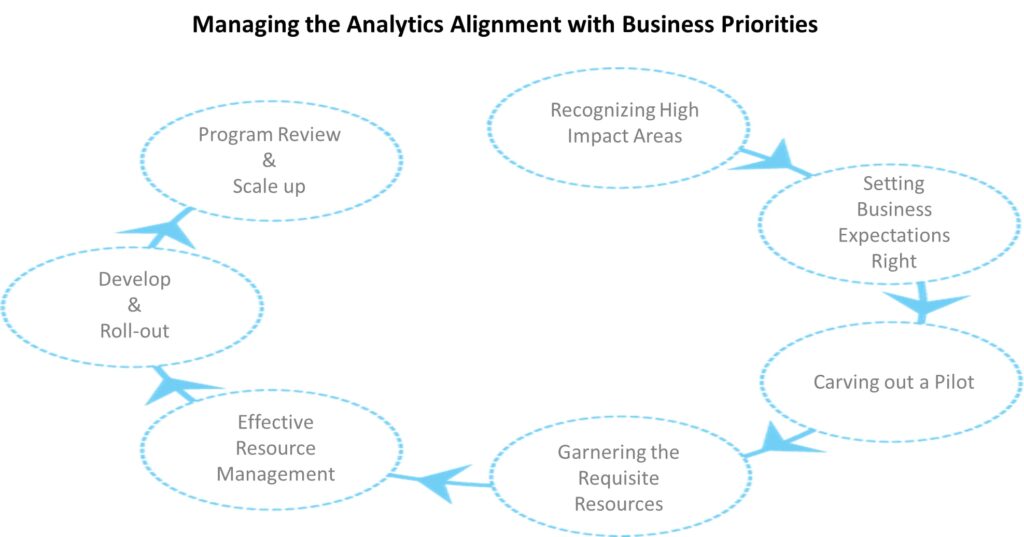Roadmap to Analytics Maturity – Part 3
3AI October 1, 2020

Hope that my earlier article would have given you a perspective on how you should be thinking about crafting an analytics roadmap for your business and the key facets to be considered before making any analytics assessments. In this article, I would want to take our discussion forward to the next level and bring to limelight som
In continuation to the earlier article, let me take the discussion a notch forward and walk through some concrete actionable steps crucial to an effective Analytics transformation initiative roll out. We are already at the cusp of a new wave of innovation in the field of advanced analytics, across almost all product lines and business functions. These significant developments would mean a far greater entrenchment of analytics talent throughout organizations, substantial improvements in organizational processes, and new services/products being developed that deliver far greater value to customers and society at large. Predominantly, till, date, investments during the initial phases in analytics were primarily managed as IT projects. Slowly, but steadily, more & more organizations are shifting their attention span to people and internal processes. Underlying phenomenon dominating this shift is the way people operate and the way typical processes happened till date, involving numerous talented managers who weren’t equipped well enough with analytics-driven decision tools. Habits die hard and such drastic shifts have to be carefully seen through when we talk about infusion of automated systems to support downstream decision-making.
While there has been tremendous impetus to invest in analytics, yet most businesses grapple with the challenges of capturing tangible business value of their analytics initiatives. Technology has definitely matured by leaps and bounds, but then that’s a universal truth that the pace of these technological advancements is way faster than the rate people could potentially adopt to. The key for businesses is to motivate their highly talented workforce, acclimatize them to these newest tools and use their creative horsepower to deliver business outcomes; outcomes which have the ability to help businesses rethink their operating model.
Coming back to our main topic of discussion here, time is ripe for organizations across the globe to understand the key ingredient to analytics success and realizing desired business impact; an integrated approach to sourcing the data, effective and scalable model building framework, and organizational change hand-in-hand for increased adoption. Analytics champions should avoid falling for starting with data and then mulling over what to do with it. Sufficient time and energy must be invested in aligning managers across the organization in support of the mission, be it through an organizational mandate to start off with. Let me start off by laying down a step by step process to help guide you through on what it takes to successfully navigate your organization through an enriching, exciting Analytics transformation journey.

Recognizing High Impact Areas
Even before we think of “making it big”, small yet crucial pieces of the puzzle need to be knitted thoroughly to craft a convincing large-scale roll-out value proposition. Initial thought process, research and analysis should carefully identify those areas which could help the business garner more revenue (increase cross-sell/up-sell, target right customers, improve pricing strategy), increase profitability or rationalize bottom-line (streamline internal processes, reduce time-to-market, mitigate foreseeable risks, manage operating expenses better). Understand the vision & mission of the business, identify which critical projects or investments the business is banking big on, what impact could analytics bring in the way frontline managers or business unit managers operate, how much of a quantifiable business benefit would it translate into….and so on. Have face-to-face meetings with the end beneficiaries, understand their day-to-day challenges at hand and convey the value analytics could bring. Place people at the heart of the initiative. Analytics teams often jump directly to model building even before the business users in sales, marketing, HR, and customer service provide their inputs. Please see that buy-in & active involvement of these individuals is the secret sauce creating an impactful case study which would establish the credibility for a large-scale roll out in the future. Business managers may discard information no matter how good it is, that they have various biases, and that they might not have the cognitive ability to use information effectively. Make sure you have them onboard all throughout the roll out journey.
Do not fall prey to picking up an easy problem or on the contrary an insurmountable one, make sure the intent initially to showcase impact and not turnaround the business upside down. Identifying the right problem to solve is the first stepping stone in the transformation journey.
Setting Business Expectation Right
What do you want Analytics to deliver is the question to be answered in this phase. Setting the right context with the senior leadership, business unit managers & frontline managers is crucial and coming out with tangible, quantifiable outcomes is imperative. Emphasize information use as the way to unlock value from IT. Do ensure that you don’t end up with too conservative numbers or even too over-ambitious. Make sure you convey outcomes in line with what’s manageable within your operating constraints and still deliver meaningful impact to the intended target audience.
Carving out a Pilot
Now that the basic building blocks are in place & impact areas identified, it’s time to prepare a thorough plan, crisply defining the problem at hand, and identifying the key stakeholders involved (you may want to put in place a steering committee to oversee the roll-out and take remedial measures in case of any unprecedented digressions). The plan has to be officially bough by all the impacted audience and the senior management to ensure that all are at an equipotential.
- Project Charter – Describe the overall project, its objectives, deliverables, timeline, steering committee members, org structure, and executives advocating the cause, and so on.
- Baseline Collaterals – Collection of materials accumulated before and during the assessment project, including project management notes, presentations, proposals and other baselines.
- Intervention Documentation– Documenting meeting minutes, interviews, and working sessions (with agendas, participants and roles, baseline collaterals used, and meeting outcomes).
- Assessment Report – Final presentation that provides the results of the assessment activities. The report includes conclusions and recommended next steps.
Garnering the Requisite Resources
Before we jump into the modeling phase, it’s crucial to answer some key questions to makes sure the bases are covered and the missing pieces of the puzzle are in place before we answer the larger problem defined in the earlier steps.
- Business Readiness – Have the needs been identified appropriately? Do we have the right set of analysts to do the job? Do we have a rack ’n’ stack what’s already in place? Do we have the required approvals to go ahead with our plan?
- Technology Readiness – Have we identified the right tools and technology? Do we already have access to those within the larger organization? Where are the gaps? If partners are needed, do you have some potentials (e.g. Analytics service providers) in mind? Is sufficient infrastructure and security in place? Do we have the right implementation partner identified?
- Data Readiness – Are the source systems mature? Do you have sufficient data coverage? Are the relevant data keepers game for sharing the data? How do we intend to fill in the gaps? Are any sources of data, beyond the walls of the organization needed, could be syndicated research or social media conversations?
Aforementioned are just a representative set of Q’s the business needs to answer before they get into the implementation phase.
Effective Resource Management
Getting the right individuals and teams in place is undoubtedly key to mining out actionable business insights. As highlighted in one of my earlier articles, putting in right team in place is one major impediment to successful analytics roll out and most of the highly sought after analyst firms have reckoned the analytics talent crunch which the industry is grappling with.
Drafting the basics of an analytics strategy automatically leads to pertinent discussions on the variety of information and capabilities required. A thorough review should uncover access to analytical talent as well as potential partnerships that might help fill gaps. In most cases the consideration of required internal and external talent or resources will often land up in those “aha” moments — as leaders quote as “data gems” residing within their business units or even recognizing the value of forging the right kind of partnership internally. Few key teams which should have the right blend of analysts and IT resources. Highlighting a few key teams here:
- Data Management Team (includes data assimilation, cleansing, harmonization etc.),
- Data Modelers or the Data Scientists roles (one who build models) to build models that predict and optimize business outcomes
- Visualization Experts (the reporting piece) who make sure insights are shared in consumable form
- Domain Experts or SME’s who understand the business at hand well
- Analytics Partner(s)
- Business Unit or Functional SPOC’s for overall alignment assessment and business impact review
Develop & Roll-out
By now, the ammunition is ready in your arsenal to brace you up for the operationalize phase. There may be some roll-backs happening to some of the earlier phases to overcome any impeding roadblocks or cross-clarify any relevant pieces which need explanation. Some key aspects for consideration here are:
- Leveraging past experience – Identify who have tried to solve this problem or similar one and the approaches they used.
- Model the solution – Formulate a detailed hypothesis about how particular variables affect the outcome.
- Data assimilation– Gather primary/secondary data or other internal data on the hypothesized variables. You may want to involve the business stakeholders here to validate the assumptions and possible trends/patterns.
- Analyze the data – Run a statistical model, assess its appropriateness for the data, and repeat the process until a good fit is found.
- Presenting the findings – Use the data to tell a story to decision makers and stakeholders so that they will take action.
Program Review & Scale up
To ensure that the plan effectiveness is in line with the objectives defined earlier, it’s crucial to have regular checkpoints and putting in place a toll gate & governance structure. Once the initial pilot has been highlighted as a success, its way easier to plan out the next steps to carve out an “across the board” roll out and infusing analytics to the business core.
Managing cultural changes and mind-sets typically is a comprehensive exercise which includes training, role modeling by the senior management, and crafting incentives payout plans and even defining concrete metrics to reinforce behavioral change in the workforce. For e.g. a large CPG organization applied such an approach successfully. It designed a sophisticated plan to bolster the profitability of promotional spending with its retailers. The initial roll-out included training championed by company management—and a new promotions analysis tool for sales reps.
However, as with any newer technology, after an initial influx of active users, the program and use of the tool started fading away. The missing ingredient here was that the company incentives were inappropriately aligned and reporting protocols for sales force still tracked sales, not profits. As a result, the managers considered that the intent of this profit-focused program was more of a business overhead that had absolutely no correlation to their key sales goals. After active brainstorming with the sales force, the company overhauled the complete program, redefined the incentive structure to include profits as a key parameter to evaluation, and customized reports to highlight profit-related data. Unarguably, the persistent training regime and mentoring was essential, the efforts gradually translated into results, with a drastic shift in the mind-set of the actual field force and promotion analytics is now an integral part of furthering the overarching goal of improving profitability.
The new age of analytics is a reality now, and my experience says that the organizations should hop onto the bandwagon sooner than later. But rather than undergoing massive overhauls, leadership to follow a piece-meal approach to embedding analytics in day-to-day business operations and slowly transforming the organizational culture. Whether an organization kick starts this transformation journey with small-scale experiments or goes big bang across the board, the deployment of analytics in a decision-making process is a complex task requiring a thoughtful and a methodical approach across several key parameters.






